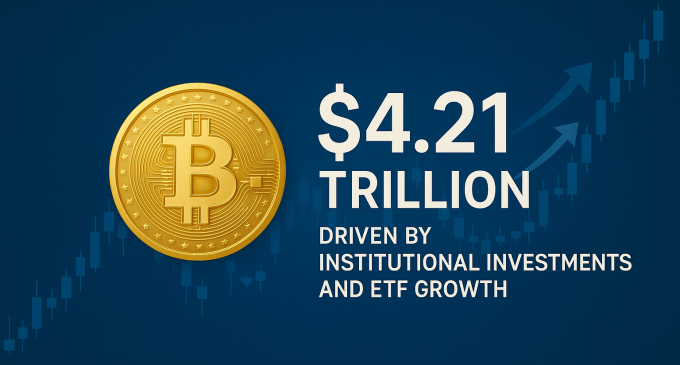
Introduction
The global cryptocurrency market has reached a historic milestone, surpassing 4.21 trillion dollars in market capitalization. This surge has been driven by a combination of strong institutional interest, growing adoption of digital assets, and substantial inflows from exchange-traded funds. The milestone highlights the growing mainstream recognition of cryptocurrencies and reflects increased confidence among institutional investors. As digital assets continue to develop, the market environment is transforming, providing both new opportunities and challenges for investors around the world.
Institutional Participation And Its Role In Market Expansion
Institutional participation has become one of the most influential factors behind the cryptocurrency market’s recent growth. Hedge funds, asset management firms, and large corporations are increasingly allocating resources to digital assets like Bitcoin and Ethereum. Their involvement not only boosts market liquidity but also strengthens credibility, encouraging more retail investment. Institutions employ advanced analytics and trading strategies that contribute to greater price stability and reduced volatility over time. Partnerships between blockchain companies and traditional financial institutions further enhance the legitimacy of cryptocurrencies, integrating them into the broader financial ecosystem.
The Influence Of Exchange-Traded Funds On Market Growth
Exchange-traded funds have become a vital channel for investment in the cryptocurrency space. ETFs allow both retail and institutional investors to access digital assets without holding them directly, offering a regulated and convenient investment vehicle. The approval and launch of several cryptocurrency ETFs have increased market participation and trading activity, thereby boosting overall market capitalization. Analysts suggest that the continued development of ETFs and related products will sustain the upward momentum and attract a broader investor base.
Performance Of Major Cryptocurrencies
Bitcoin continues to lead the market, approaching record highs thanks to strong institutional backing. Ethereum maintains a robust position due to its smart contract capabilities and thriving decentralized finance ecosystem. Altcoins such as XRP, Solana, and Polkadot show resilience despite market fluctuations, indicating diversified interest among investors. The growth across multiple digital assets reflects a mature market driven increasingly by adoption and technological developments rather than speculation alone.
Technological Advancements Supporting Market Growth
The rise in cryptocurrency market capitalization coincides with notable technological progress. Improvements in blockchain scalability, the expansion of decentralized finance platforms, and innovations in cross-chain interoperability have strengthened the infrastructure supporting digital assets. Enhanced security measures and user-friendly platforms have increased adoption among retail and institutional investors. Regulatory-compliant technology infrastructure further facilitates mainstream participation, helping digital assets secure their place as a recognized asset class.
Regulatory Developments And Market Implications
Clear regulatory frameworks play a crucial role in building investor confidence and shaping market trends. Governments worldwide are gradually implementing rules for trading, taxation, and compliance. Positive regulatory milestones, such as the formal recognition of digital assets in financial systems, have boosted legitimacy and encouraged institutional participation. Conversely, areas with regulatory uncertainty can experience heightened volatility. Overall, a stable and transparent regulatory environment is essential for continued growth and attracting a diverse investor base.
Environmental And Sustainability Considerations In Crypto
As the cryptocurrency market grows, environmental concerns have come to the forefront, particularly regarding energy-intensive proof-of-work mining processes. Bitcoin and other cryptocurrencies have faced criticism for their carbon footprint, prompting the development of more energy-efficient protocols such as proof-of-stake. Companies and investors are increasingly prioritizing sustainable practices, including renewable energy-powered mining and carbon offset initiatives. Addressing environmental concerns is critical for long-term adoption, regulatory approval, and alignment with global sustainability goals.
The Role Of Decentralized Finance And Emerging Applications
Decentralized finance, or DeFi, has become a major growth driver in the cryptocurrency ecosystem. By removing intermediaries, DeFi platforms offer lending, borrowing, and trading services directly on blockchain networks. These applications are expanding the use cases for cryptocurrencies and attracting both institutional and retail participants. Emerging sectors such as non-fungible tokens (NFTs), metaverse integrations, and blockchain gaming are also contributing to market dynamism, providing additional investment opportunities and technological innovation.
Future Outlook And Strategic Considerations
Looking forward, the cryptocurrency market is expected to expand further due to institutional adoption, innovative financial products, and ongoing technological improvements. Investors increasingly view digital assets as a component of diversified portfolios, recognizing their potential for long-term returns. Strategic investment approaches that balance risks with opportunities, combined with informed decision-making, will be critical for navigating the evolving market. Analysts predict that as infrastructure and adoption continue to improve, the global cryptocurrency market may reach even higher valuations, solidifying its role in the financial ecosystem.
Conclusion
The global cryptocurrency market surpassing 4.21 trillion dollars underscores the sector’s growth and increasing acceptance by mainstream investors. Institutional investments, ETF inflows, technological innovation, regulatory clarity, sustainability initiatives, and the rise of decentralized finance have all contributed to this achievement. As cryptocurrencies continue to evolve, they present both opportunities and challenges for investors seeking to engage with this transformative financial sector. Sustained growth will depend on continued innovation, regulatory progress, and strategic engagement from a broad spectrum of market participants.







There are no comments at the moment, do you want to add one?
Write a comment